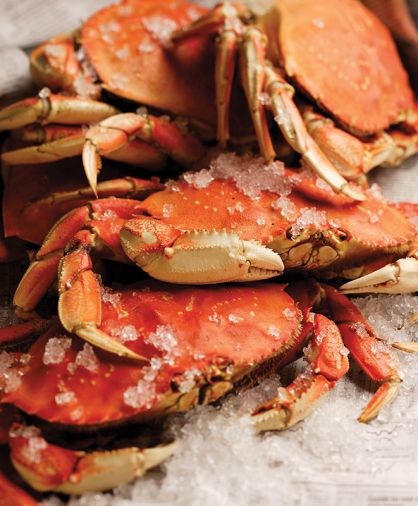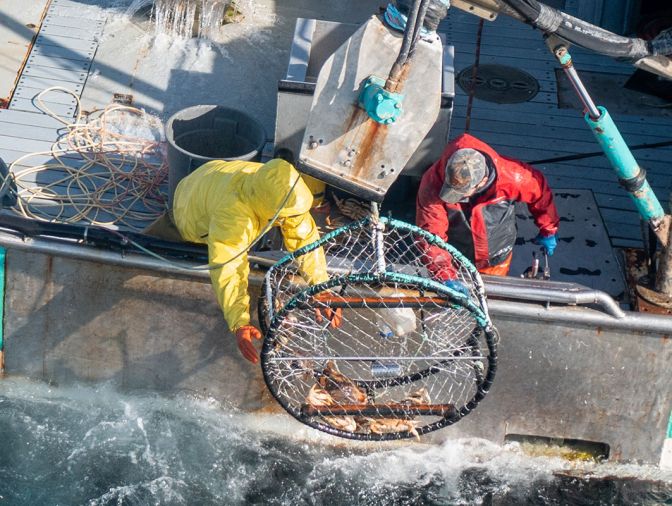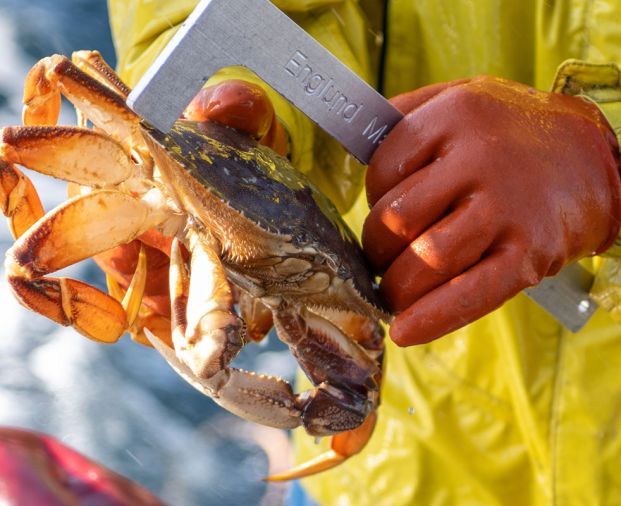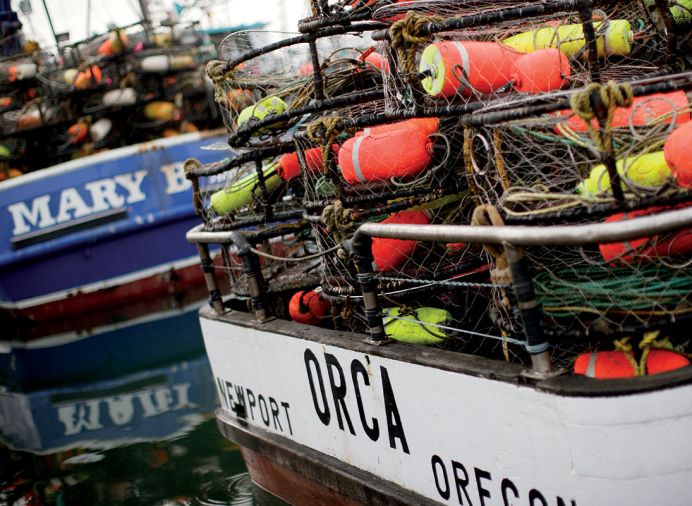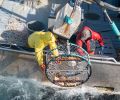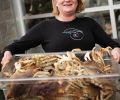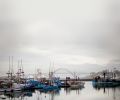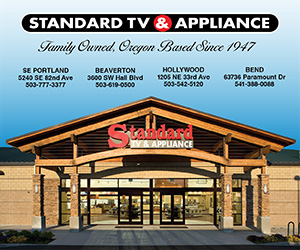A silvery fog shrouds the Newport docks and shimmers across tips of towering spruce trees, while the wind howls and rain falls sideways. It’s just before 8:00am on a Saturday morning and from afar the docks appear sleepy. Zoom in and a Bruce Springsteen ballad blasts from the F/V Orca, where fishers clad in slick orange waders prep for the most important season of the year.
The port of Newport is home of one of the largest and most productive fishing fleets on the West Coast and it’s often busy from dawn to dusk. But in December, at the start of Dungeness crab season, when roughly 325 boats are stacked with colorful traps and the crews are raring to go — the harbor is all vim and vigor. “The energy is palpable,” says Bob Eder. “And when we go, it’s kind of like the Oklahoma land rush.”
A first-generation fisher, Eder found his way to commercial fishing over fifty years ago. He was on track for a career in academia, but following a stint on a commercial fishing boat, he was hooked. “It’s very purpose-driven work. Going out and harvesting food in this ancient way and bringing it back to the community. It’s an archetypal experience every time,” he says.
Newport’s nautical heritage hails back to 1882 when the Bayfront was the economic backbone of the city, housing both a port for commercial fishing and the timber industry. Today, the Bayfront is home to Oregon’s largest commercial fishing fleet and also ranks in the top fifteen for fishery landings in the nation.
“The fleet is incredibly diverse, we have everything from small 20-foot wooden dory to boats to steel vessels that are over 100-feet,” says Eder. The boats venture out year round, fishing by designated seasons — ranging from halibut and albacore to sablefish and salmon. But the most lucrative catch is Dungeness crab, and Newport holds the crown for the “Dungeness Crab Capital of the World.”
Eder captains F/V Timmy Boy, a 60-foot long steel hull boat that dates back to 1968. He has permits for multiple fisheries including crab and black cod. The latter is managed as a quota fishery, which means the fishers know how much they have access to. “It’s a little more civilized,” says Eder with a smile. “I call it family style — we all eat and sleep at the same time.”
Dungeness crab is a derby fishery, where fishers compete to catch the most fish in a restricted period. “Everyone’s after the same crab, so it’s super competitive,” says Eder. Once boats get the green light, they run back-to-back trips for the first few weeks, returning only to unload and sleep for a few hours.
“When we start fishing, our rotation is 18 hours on, six hours off,” says Eder. It might sound extreme, but it’s not, it’s vital to persevere. Up to 75% of the annual production is landed in the first eight weeks of the season.
The ocean is a very different place in the winter months than in the summer, adds Eder. “It’s like working during an earthquake but it’s also very wet.” Maybe you’ve seen an episode of the Deadliest Catch, a riveting show that chronicles crab fishing off the Alaskan coast on the icy Bering Sea? It’s just as dangerous — if not more — for Oregon’s fishers.
In addition to storms and squally weather, the risk is maximized when boats cross the Yaquina Bay bar — the shallowest area before heading out to sea. Every year, an average of one or two fishermen lose their lives at sea. It’s a reminder that the words from poet Walter Scott (circa 1816) still ring true today: It’s no fish ye’re buying, it’s men’s lives.
“Water is powerful, it can bend steel and turn wood into toothpicks,” says Corey Feldner, another crabber who fishes out of Newport. He moved from North Dakota to fish with his uncle one summer, fell for the autonomous life at sea, and never left. Twenty-five years later, he’s now running the F/V Granville, a seventy-year old, 45-foot vessel crafted of solid wood.
Like the other commercial boats, his is stocked with brightly colored buoys that mark his crab pots. The pots have different lengths of line, ranging from 30 to 600 feet deep. As Feldman drives the boat, his two-man crew uses a winch to haul each 100-pound crab pot up through the waves at about 50-miles per hour.
Once on deck, the crew sorts the male and female crabs, quickly re-baits the pot and tosses it overboard before the boat coasts up to the next buoy, which is about a football field away. “Just like connecting the dots,” says Feldner. But at lightning speed. Each pot takes a minute and the herculean process will be repeated up to 300 times in one day.
There’s an intricate rhythm to the work only steadfast fishers know. If you see the crab boats from the beach, it looks like they are moving very slowly, but in fact, they are working at full tilt. Despite the relentless pace, Feldman can’t imagine any other career. “Fishing means something,” he says. “It’s feeding people.”
Bob Kemp helms the 51-foot F/V My Lee, a boat built in 1975 during the war efforts. For him, fishing is a lifestyle, not just a business. “I try to put as many days at sea as I can,” he says.
The ocean captivated Kemp at an early age. “I was five years old when my father built a small skiff and from there we would go out on a port and fish,” he says.
“My work is my play,” he says. You know that tune, he asks? He hums and sings the lyrics to a famous ballad by folk singer Bob Franke: “What can you do with your days but work and hope. Let your dreams bind your work to your play.”
Kemp crabs with a 300 pot-permit, which is considered a medium sized operation. He prefers crabbing a few weeks after the season starts. “The big boats leave after the first few days of crabs and the smaller boats thrive,” he says. Volume goes down, and the price goes up.
He explains how the hundreds-year-old fishery ensures a sustainable harvest each year. The fishery keenly understands the importance of preventing over-harvesting to ensure the longevity of the species. It follows a system known as the 3 S’s – Size, Sex & Season. Only mature male crabs (measuring at least 6¼ inches across the back of the shell) are harvested. Undersized male crabs are returned to the ocean. All female Dungeness crabs are released to ensure future healthy stocks. And the season follows state-restricted dates for fishing.
Additionally, the state-managed fishery imposed a system of limited entry to minimize the prospects of over-capitalization. Only 450 crab permits exist, which means the fleet will never exceed that level. And in 2006, a pot limit went into effect that reduced the number of pots in the ocean by 50,000 and capped the number any one permit-holder could fish at 500.
As a result, the fishery and the Dungeness crab population is thriving. “That’s the beauty of not over-harvesting,” says Kemp. It’s one of many reasons he’s interested in direct sales with the community, to share these success stories. “It’s important that the public gets a chance to talk to fishers,” he says. Every year, thousands of visitors head to Newport just to see a working waterfront. “Our goal as a fleet is to put an identity, a face on who caught what.”

